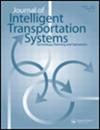低穿透率轨迹数据下交通控制的自适应绿裂优化
IF 2.8
3区 工程技术
Q3 TRANSPORTATION
Journal of Intelligent Transportation Systems
Pub Date : 2024-11-01
DOI:10.1080/15472450.2023.2227959
引用次数: 0
摘要
自适应交通信号控制系统通常依赖于昂贵的物理检测基础设施。然而,随着广泛的轨迹数据的出现,现在可以实现完全避免此类成本的自适应控制。我们提出了两种简单的自适应控制策略,它们只需要采样延迟和停止次数,目的是减轻过饱和的存在。之所以简单,是因为需要在任意弹道突防速率下进行控制。这两种策略在实现控制基础设施的可能性上有所不同。第一种是通过偏离参考的预定时信号计划来最小化过饱和。该信号平面可以是现有的信号平面,也可以是综合轨迹数据估计出来的信号平面。第二个策略首先创建一组绿色分割计划,然后由控制逻辑选择。第二个策略旨在用于类似scats的系统,其中信号计划仅限于预定义的离散集。我们提出了一个计划选择逻辑,或者,也可以使用原始的计划选择策略。这两项政策都在实地进行了测试,显著降低了延迟、过饱和和溢出比率。最后,我们测试了该策略的应用,作为SCATS系统在存在故障物理探测器的情况下的增强。本文章由计算机程序翻译,如有差异,请以英文原文为准。
Adaptive green split optimization for traffic control with low penetration rate trajectory data
Adaptive traffic signal control systems often rely on expensive physical detection infrastructure. However, with the advent of widespread trajectory data, it is now possible to implement adaptive control entirely avoiding such costs. We present two simple adaptive control policies which only require sample delay and number of stops, with the goal to mitigate the presence of oversaturation. The simplicity stems from the necessity of controlling under any trajectory penetration rate. The two policies differ on the possibilities of the control infrastructure to be implemented. The first one minimizes oversaturation by deviating from a reference pre-timed signal plan. This signal plan can be an existing one or an estimated one from aggregating trajectory data. The second policy creates first a set of green split plans to be then selected by a control logic. This second policy is intended to be used in SCATS-like systems where signal plans are limited to a pre-defined discrete set. We propose a plan selection logics or alternatively, the original plan selection policy can be used as well. Both policies are tested in the field, achieving a significant reduction in delay, oversaturation and spillover ratios. Lastly, we test an application of this policy as an enhancement of SCATS systems in the presence of malfunctioning physical detectors.
求助全文
通过发布文献求助,成功后即可免费获取论文全文。
去求助
来源期刊
CiteScore
8.80
自引率
19.40%
发文量
51
审稿时长
15 months
期刊介绍:
The Journal of Intelligent Transportation Systems is devoted to scholarly research on the development, planning, management, operation and evaluation of intelligent transportation systems. Intelligent transportation systems are innovative solutions that address contemporary transportation problems. They are characterized by information, dynamic feedback and automation that allow people and goods to move efficiently. They encompass the full scope of information technologies used in transportation, including control, computation and communication, as well as the algorithms, databases, models and human interfaces. The emergence of these technologies as a new pathway for transportation is relatively new.
The Journal of Intelligent Transportation Systems is especially interested in research that leads to improved planning and operation of the transportation system through the application of new technologies. The journal is particularly interested in research that adds to the scientific understanding of the impacts that intelligent transportation systems can have on accessibility, congestion, pollution, safety, security, noise, and energy and resource consumption.
The journal is inter-disciplinary, and accepts work from fields of engineering, economics, planning, policy, business and management, as well as any other disciplines that contribute to the scientific understanding of intelligent transportation systems. The journal is also multi-modal, and accepts work on intelligent transportation for all forms of ground, air and water transportation. Example topics include the role of information systems in transportation, traffic flow and control, vehicle control, routing and scheduling, traveler response to dynamic information, planning for ITS innovations, evaluations of ITS field operational tests, ITS deployment experiences, automated highway systems, vehicle control systems, diffusion of ITS, and tools/software for analysis of ITS.

 求助内容:
求助内容: 应助结果提醒方式:
应助结果提醒方式:


